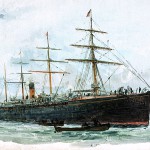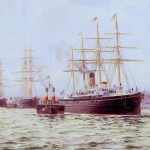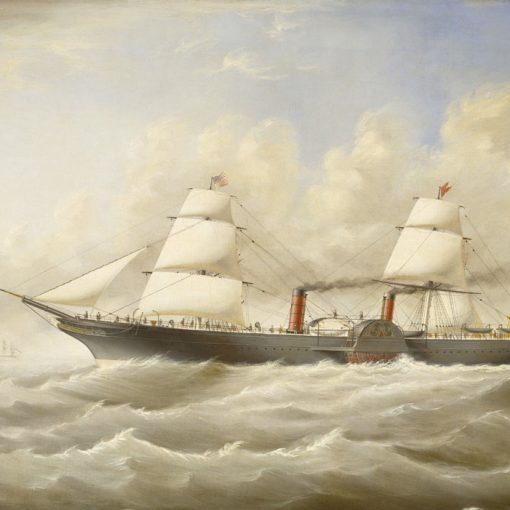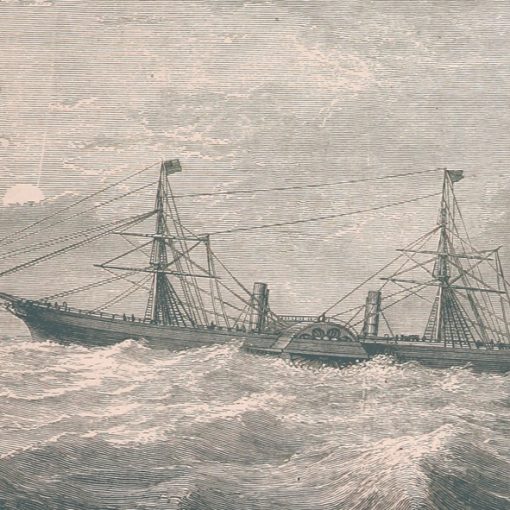1872 – 1899
In 1871, the Oceanic Steam Navigation Company – or the White Star Line – had started business with their first steamer on the oceans. She was the Oceanic, and soon she was known as the best liner on the North Atlantic. Along with the Oceanic, three sisters to her were also ordered. The first of them – the Atlantic – emerged three months after the Oceanic and was followed by the Baltic and Republic. Just as the Oceanic, these ships became successes on the North Atlantic. In order to maintain a fleet that stood up to the requirements by the passengers, another two vessels with a slightly higher gross tonnage were ordered.
Already on June 8, 1871, the first of these two sisters was launched. Her intended name was Arctic, but as the American Collins Line had a paddle steamer with that name that sunk in 1854, White Star reconsidered the name and came up with the perhaps better Celtic. The second sister was also launched in 1871, on October 17. She was called Adriatic, named after the sea in between Italy and former Yugoslavia.
During the Adriatic’s fitting out in late 1871 and early 1872, a novelty was tested upon before the maiden voyage. Earlier, ships had had oil lamps, but on the Adriatic gas lamps were now installed. A machine in the engine room produced the gas from coal. The Adriatic was the first ship with such a thing. The famous Great Eastern had used gas, but she did not have a machine to manufacture the gas on board, and had to be filled up when at port. However, when the Adriatic was exposed to bad weather the gas started to leak. This was considered too big a problem, so the idea of gas was abandoned before the maiden voyage, when the Adriatic had conventional oil lamps and candle lights.
On April 11, 1872, the Adriatic set out on her maiden voyage between Liverpool and New York. She was under the command of Captain Digby Murray, the same man that had been the master on board the Oceanic on her maiden voyage the previous year. The Adriatic was a fine sight, of the conventional style, rather similar to the Oceanic-class. She sported a long black hull, a single funnel and four masts of which three were rigged. The masts stretched some 150 feet up in the air, so the Adriatic sure made quite an impression.
There were many reasons to celebrate the Adriatic’s maiden voyage, but the most prestigious thing happened a month later when she reached New York and had taken the Blue Riband from the Cunard Line’s paddle steamer Scotia, who had held the prize in her grasp since 1866 when she received it. The Adriatic had managed to maintain a good 14.52 knots as service speed during the Atlantic crossing.
After all the glory and celebration had calmed itself down, what was left for the Adriatic was a distinguished career in the White Star Line. As she was the largest ship in their fleet, she received the rank of flagship. She held that title until June 1874, when the brand new 5,000-ton Britannic entered service.
In October the same year, the Adriatic suffered her first noteworthy accident. When leaving New York she steamed parallel with the Cunarder Parthia. Suddenly, the two ships were sucked towards each other due to the forces of nature. Fortunately, the damages to the two ships were not too extensive – only some paint was scratched off from the side hull-plates. But if the lifeboats had been swung out – as customary on a crossing in those days – the consequences could have been much worse.
In May the following year two other more severe accidents including the Adriatic occurred. In March she accidentally rammed and sank the American steamer Columbus in New York waters. Seven months later, in December, the Adriatic ran down and sank the sailing vessel Harvest Queen in St. George’s Channel. The collision happened so quickly and as there were no survivors from the sailing ship, no one knew what vessel they had sunk. Records later showed that the Harvest Queen was missing and that was how the identification was made.
The Adriatic continued for the next three years without any major mishaps, but on July 19, 1878, she cut into the brigantine G. A. Pike just off Tuscar Rock in South Wales. Five men of the latter vessel lost their lives. Later, the Adriatic was blamed for having travelled at a speed too high for the circumstances.
The Adriatic continued on her successful North Atlantic service in the same appearance as she had sported at the time of her maiden voyage. However, in 1884, she went through a minor refit that included the adding of accommodation for 50 second class passengers. Earlier, there had only been two classes – first and steerage.
Another spotless fourteen years went on until the Adriatic was considered too old for a passenger service on the North Atlantic. She was laid up as a reserve ship at Birkenhead. Two years later – 1899, the same year the White Star Line’s first real ‘superliner’, the second Oceanic entered service – the Adriatic was sold for scrap. On February 12, she arrived at the scrapyards of Thomas W. Ward in Preston. Of the original six main White Star liners only the Republic remained. She would be scrapped in 1910 as the Italian ship Citta di Napoli.
Specifications
- 452 feet (138.1 m) long
- 40.9 feet (12.5 m) wide
- 3,888 gross tons
- Four Maudslay & Field steam engines powering a single propeller
- 14.5 knot service speed
- Passenger capacity of 850 people








